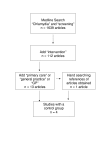Interventions for increasing chlamydia screening in primary care: a review
- PMID: 17547745
- PMCID: PMC1896158
- DOI: 10.1186/1471-2458-7-95
Interventions for increasing chlamydia screening in primary care: a review
Abstract
Background: Despite guidelines recommending opportunistic chlamydia screening of younger women, screening rates in some countries remain low. Our aim was to review the evidence for specific interventions aimed at increasing chlamydia screening rates in primary care.
Methods: A Medline search was conducted for controlled trials that assessed the effectiveness of interventions aimed at improving chlamydia screening rates in primary health care settings. The Medline search was done for studies in English published prior to December 2005 using the following key words: chlamydia, screening, intervention, primary care and GPs. In addition, the references cited in the articles were reviewed. Studies in English published prior to December 2005 were reviewed.
Results: Four controlled studies met the inclusion criteria--3 were randomized studies and one was not. Strategies to increase screening rates included the use of educational packages targeting primary care physicians and the correction of barriers to screening within clinic systems. In 3 studies, the intervention was associated with an increase in screening rates of between 100% and 276% (p < 0.04). In the fourth study, the intervention was associated with a significant attenuation in declining screening rates over time (4% versus 34% decline, p = 0.04).
Conclusion: There are only a limited number of randomized or controlled studies that demonstrate improved chlamydia screening of younger women in primary care.
Figures
References
-
- World Health Organization . Global prevalence and incidence of selected curable sexually transmitted infections: overview and estimates. Geneva: WHO; 2001.
-
- Mertz KJ, Levine WC, Mosure DJ, Berman SM, Dorian KJ. Trends in the prevalence of chlamydial infections: the impact of community wide testing. Sex Trans Dis. 1997;24:169–75. - PubMed
Publication types
MeSH terms
LinkOut - more resources
Full Text Sources
Medical
Miscellaneous


